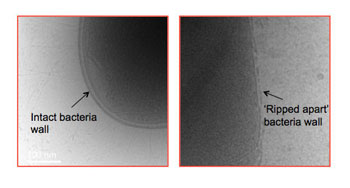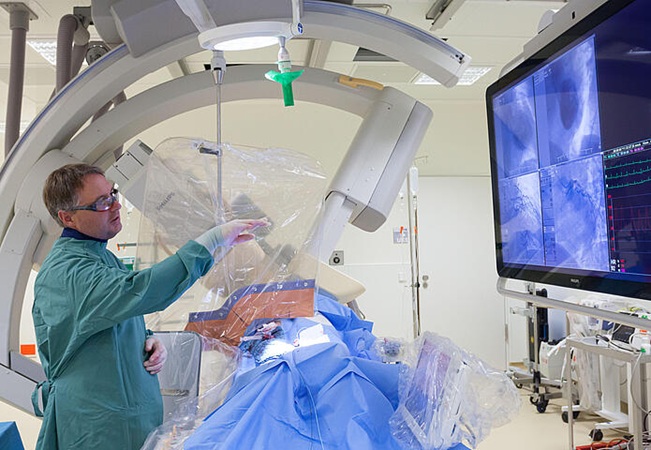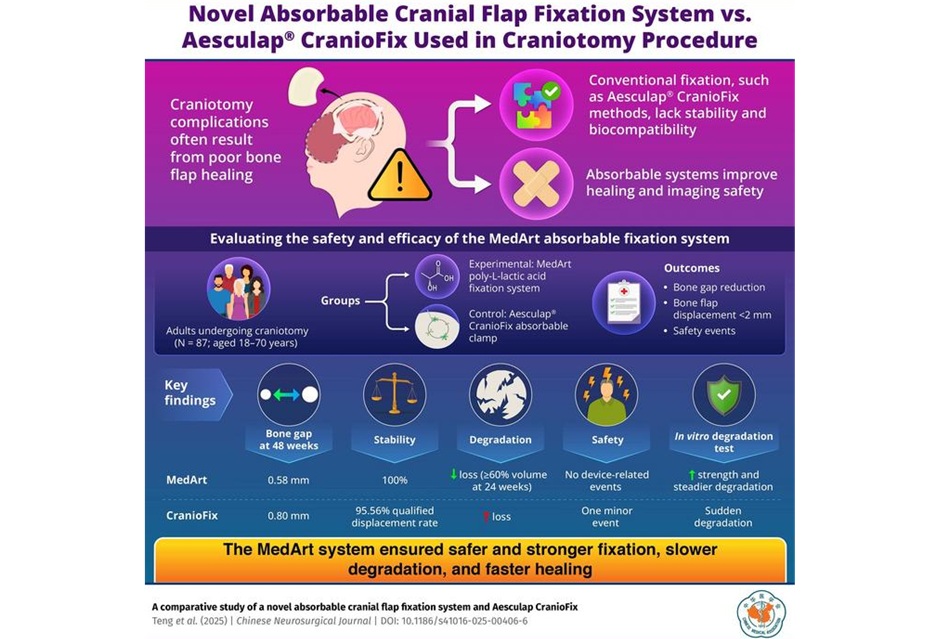Star-Shaped Polymers Kill Antibiotic Resistant Bacteria
|
By HospiMedica International staff writers Posted on 05 Oct 2016 |

Image: A bacteria cell before (L) and after treatment (R) with star-shaped polymers (Photo courtesy of UNIMELB).
A new study suggests that structurally nanoengineered antimicrobial peptide polymers (SNAPPs) could provide a low-cost and effective antimicrobial agent against multidrug resistant (MDR) bacteria.
Developed by researchers at the University of Melbourne (UNIMELB; Parkville, Australia), the star-shaped SNAPP is extremely effective at killing Gram-negative bacteria while being non-toxic to the body’s own cells, thanks to its unique antimicrobial activity. SNAPPs induce cell death by a multimodal mechanism that combines outer membrane destabilization, unregulated ion movement across the cytoplasmic membrane, and induction of the apoptotic-like death pathway.
The SNAPPs exhibited sub-μM activity against all Gram-negative bacteria tested, including the ESKAPE (Enterococcus faecium, Staphylococcus aureus, Klebsiella pneumoniae, Acinetobacter, Pseudomonas aeruginosa and Enterobacter) pathogens and other colistin-resistant and MDR (CMDR) pathogens, while demonstrating low toxicity. In addition, the researchers did not observe any resistance acquisition by A. baumannii (including the CMDR strain) to SNAPPs. The study was published on September 12, 2016, in Nature Microbiology.
“It is estimated that the rise of superbugs will cause up to ten million deaths a year by 2050. In addition, there have only been one or two new antibiotics developed in the last 30 years,” concluded senior author Professor Greg Qiao, PhD, of the department of chemical and biomolecular engineering, and colleagues. “Overall, SNAPPs show great promise as low-cost and effective antimicrobial agents, and may represent a weapon in combating the growing threat of MDR Gram-negative bacteria.”
Antimicrobial polymers are engineered to mimic peptides used by the immune systems of living things to kill bacteria. Typically, they are produced by attaching or inserting an active antimicrobial agent onto a polymer backbone via an alkyl or acetyl linker. The use of antimicrobial polymers may enhance the efficiency and selectivity of common antimicrobial agents, while decreasing associated environmental hazards since they are generally nonvolatile and chemically stable.
Related Links:
University of Melbourne
Developed by researchers at the University of Melbourne (UNIMELB; Parkville, Australia), the star-shaped SNAPP is extremely effective at killing Gram-negative bacteria while being non-toxic to the body’s own cells, thanks to its unique antimicrobial activity. SNAPPs induce cell death by a multimodal mechanism that combines outer membrane destabilization, unregulated ion movement across the cytoplasmic membrane, and induction of the apoptotic-like death pathway.
The SNAPPs exhibited sub-μM activity against all Gram-negative bacteria tested, including the ESKAPE (Enterococcus faecium, Staphylococcus aureus, Klebsiella pneumoniae, Acinetobacter, Pseudomonas aeruginosa and Enterobacter) pathogens and other colistin-resistant and MDR (CMDR) pathogens, while demonstrating low toxicity. In addition, the researchers did not observe any resistance acquisition by A. baumannii (including the CMDR strain) to SNAPPs. The study was published on September 12, 2016, in Nature Microbiology.
“It is estimated that the rise of superbugs will cause up to ten million deaths a year by 2050. In addition, there have only been one or two new antibiotics developed in the last 30 years,” concluded senior author Professor Greg Qiao, PhD, of the department of chemical and biomolecular engineering, and colleagues. “Overall, SNAPPs show great promise as low-cost and effective antimicrobial agents, and may represent a weapon in combating the growing threat of MDR Gram-negative bacteria.”
Antimicrobial polymers are engineered to mimic peptides used by the immune systems of living things to kill bacteria. Typically, they are produced by attaching or inserting an active antimicrobial agent onto a polymer backbone via an alkyl or acetyl linker. The use of antimicrobial polymers may enhance the efficiency and selectivity of common antimicrobial agents, while decreasing associated environmental hazards since they are generally nonvolatile and chemically stable.
Related Links:
University of Melbourne
Latest Critical Care News
- Coronary Artery Stenosis Could Protect Patients from Pulmonary Embolism Effects
- Sweat-Powered Sticker Turns Drinking Cup into Health Sensor
- Skin-Mounted 3D Microfluidic Device Analyzes Sweat for Real-Time Health Assessment
- New Therapeutic Brain Implants to Eliminate Need for Surgery
- Stem Cell Patch Gently Heals Damaged Hearts Without Open-Heart Surgery
- Biomaterial Vaccines to Make Implanted Orthopedic Devices Safer
- Deep Learning Model Predicts Sepsis Patients Likely to Benefit from Steroid Treatment
- Programmable Drug-Delivery Patch Promotes Healing and Regrowth After Heart Attack
- Breakthrough Ultrasound Technology Measures Blood Viscosity in Real Time
- Magnetically Activated Microscopic Robotic Swarms Could Deliver Medicine Inside Body
- Frequent ECG Use Can Identify Young People at Risk of Cardiac Arrest
- Ultrasound Controlled Artificial Muscles Pave Way for Soft Robots
- AI-Powered Alerts Reduce Kidney Complications After Heart Surgery
- Algorithm Predicts and Lengthens Pacemaker Battery Life
- Novel Pill Could Mimic Health Benefits of Bariatric Surgery
- AI Models Identify Patient Groups at Risk of Being Mistreated in Hospital ED
Channels
Surgical Techniques
view channel
Drug-Coated Balloons Can Replace Stents Even in Larger Coronary Arteries
Narrowed or blocked arteries pose a major global health burden, often leading to heart attacks, heart failure, or stroke when blood flow becomes compromised. Traditional balloon angioplasty can reopen... Read more
Magnetic Kidney Stone Retrieval Device Outperforms Ureteroscopic Laser Lithotripsy
Kidney stone disease affects millions worldwide and often requires ureteroscopic laser lithotripsy, yet fragment removal remains inefficient. Many patients are left with residual pieces that can cause... Read more
Absorbable Skull Device Could Replace Traditional Metal Implants Used After Brain Surgery
Closing the skull safely after neurosurgery remains a major clinical challenge, as traditional metal or semi-absorbable fixation devices can interfere with imaging, degrade unpredictably, or persist long... Read morePatient Care
view channel
Revolutionary Automatic IV-Line Flushing Device to Enhance Infusion Care
More than 80% of in-hospital patients receive intravenous (IV) therapy. Every dose of IV medicine delivered in a small volume (<250 mL) infusion bag should be followed by subsequent flushing to ensure... Read more
VR Training Tool Combats Contamination of Portable Medical Equipment
Healthcare-associated infections (HAIs) impact one in every 31 patients, cause nearly 100,000 deaths each year, and cost USD 28.4 billion in direct medical expenses. Notably, up to 75% of these infections... Read more
Portable Biosensor Platform to Reduce Hospital-Acquired Infections
Approximately 4 million patients in the European Union acquire healthcare-associated infections (HAIs) or nosocomial infections each year, with around 37,000 deaths directly resulting from these infections,... Read moreFirst-Of-Its-Kind Portable Germicidal Light Technology Disinfects High-Touch Clinical Surfaces in Seconds
Reducing healthcare-acquired infections (HAIs) remains a pressing issue within global healthcare systems. In the United States alone, 1.7 million patients contract HAIs annually, leading to approximately... Read moreHealth IT
view channel
Printable Molecule-Selective Nanoparticles Enable Mass Production of Wearable Biosensors
The future of medicine is likely to focus on the personalization of healthcare—understanding exactly what an individual requires and delivering the appropriate combination of nutrients, metabolites, and... Read moreBusiness
view channel
Philips and Masimo Partner to Advance Patient Monitoring Measurement Technologies
Royal Philips (Amsterdam, Netherlands) and Masimo (Irvine, California, USA) have renewed their multi-year strategic collaboration, combining Philips’ expertise in patient monitoring with Masimo’s noninvasive... Read more
B. Braun Acquires Digital Microsurgery Company True Digital Surgery
The high-end microsurgery market in neurosurgery, spine, and ENT is undergoing a significant transformation. Traditional analog microscopes are giving way to digital exoscopes, which provide improved visualization,... Read more
CMEF 2025 to Promote Holistic and High-Quality Development of Medical and Health Industry
The 92nd China International Medical Equipment Fair (CMEF 2025) Autumn Exhibition is scheduled to be held from September 26 to 29 at the China Import and Export Fair Complex (Canton Fair Complex) in Guangzhou.... Read more













